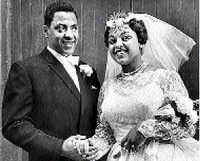
In the '50s and '60s, there were only black and white photos of weddings. Today, everything is in colour and black and white pictures are only done upon special request. As an added bonus, weddings are also videotaped and presented to the couple in DVD format. Whereas wedding albums were the thing once upon a time, photographers supply a CD with the proofs today. - FILE
This is the second in our bi-monthly series and in the first story, we looked at some of the differences between how people from uptown and downtown conduct funeral arrangements. This week, we look at the way weddings are conducted by rural and urban folk.
The Planning
A few decades ago, rural folk simply told everyone in the family and the district that they would be getting married on such and such a date. They then proceeded to order the cake from the person in the community reputed to make the best-tasting cake and see the best dressmaker/tailor, etc. People who live in 'foreign' would be given early notice too. They then set about fattening the pigs, goats, chicken and cow (if means allowed), for the big event. Everyone chipped in to help, no wedding planner required.
The Day
In rural Jamaica, wedding day was strictly Wednesday because the couple dressed up again in its finery and went back to church to return thanks to the congregation and community for all the love and support, on the Sunday after the wedding day.
The Cake
This was special and was borne to the bride's home or reception destination the day before the wedding, on the head of a young woman (preferably a virgin). Children enjoyed running behind her and admiring the beautifully decorated cake as it sat on a wooden tray. Old wives' tale claimed that if she looked back, it was bad luck or the cake would crack and that was a bad omen for the couple. It was also fun to watch grown people scrambling to pick up cake crumbs that had fallen to the ground fearing bad luck if dogs ate them.
The Reception
Rural wedding receptions do not usually follow a formal programme. The master of ceremonies is usually the person in the district who has the gift of gab. This person keeps things going while allowing anyone who "has something to say" to give a toast. These toasts are more humorous than meaningful and elicit grunts and nods of agreement from the gathering. The location is usually the bride's home and the stones/tree trunks are white-washed and an arch made of coconut boughs is woven and decorated with flowers. Seating is free, sometimes there's standing room only and the aroma of curried goat and mannish water fills the air. The event remains the main topic of conversation for months!
URBAN STYLE
The Planning
This is usually left to a wedding planner with instructions from the bride's family or the couple. Prices vary, but the more lavish, the bigger the bucks. Planners are equipped to take care of every detail from the minister to the honeymoon and eliminate most of the stress and headache of the big day.
The Day
Urban-style weddings see a day of all the elements coming together. From the ceremony at the church to the first dance at the reception and throwing the bouquet. Details such as tokens for guests, special seating arrangements, and a special area for children if they have been allowed to attend. Formal picture-taking sessions at a pre-selected location is also taken into consideration.
The Cake
The wedding cakes of urban couples exude sophistication and simplicity. They follow the wedding colour theme and many of them feature fresh floral arrangements and toppings other than the plastic bride and groom.
The Reception
Guests usually can't wait to enter the hotel, garden, restaurant, or upscale event venue where the urban wedding reception takes place. Decor is usually lavish and the higher up the social ladder or deeper the pockets, the more extravagant the preparations.
Guests make every effort to outdo the bridal party in their attire and the master of ceremonies is usually a learned individual capable of injecting humour while bordering on verbose. Music is usually live and recorded and the menu is outlined on the programme that sets out details of who will make each formal toast.

Bridal bouquets selected by the urban bride are definitely made from fresh flowers and in the latest designs like these that can be sourced by Island Bride. - Contributed